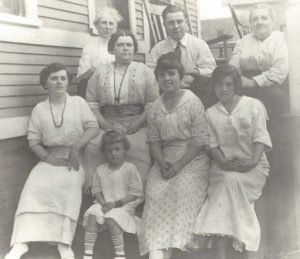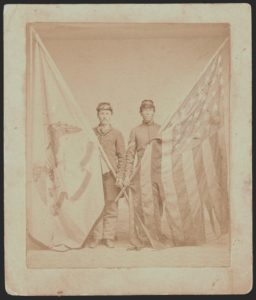Antietam Burnside Mann (c. 1915)
9 May 2024
Peter Mann married in his native Scotland in 1831, came to America in the next year or two, and had 10 children with his wife Isabella before she died in 1855. He married again, in 1857, Ann Martin Dyson, a woman who had also lost her spouse. They had a daughter Mary Agnes in 1858.
In September 1861 Peter, then a 54 year old weaver in Enfield, CT, enlisted as a Private in the 8th Connecticut Infantry. A year later he was terribly wounded in battle at Antietam, and died there on 27 September 1862. Four months later his widow Ann had their second daughter and named her Antietam Burnside Mann (1863-1943).
Antietam never married, but did not lack the company of children.
That’s her, back row at left, with her sister Mary Agnes Mann Richardson (1858-1929), back right, in about 1915. Mary Agnes’ oldest, Annie Elizabeth Richardson Breyer (b. 1877) is just in front of Antietam; Annie’s son Leland Eugene Breyer (1898) is top center. In front, left to right are 3 of Mary Agnes’ other daughters and a grand-daughter: Florence Richardson Goddu (1885), Inez Bingham (later Mansur, 1908), Inez Viola Richardson (later Allis, 1894), and Vera Antietam Richardson (later Huntley, 1895).
This lovely photograph was contributed to Antietam’s memorial by descendant Owen C Waggoner, Jr., who also identified all of those faces for us.
I’m guessing the date of the photograph from the apparent ages of the subjects, particularly Inez Bingham, who looks about 7.
Private Wheeler’s stump (1862)
8 May 2024
Specimen 2746. A cast of the left leg, after amputation, as if by the posterior flap, in the upper third. The cicatrices resemble those following a circular amputation. The integument appears tightly drawn over the bone on the anterior surface. Private J. W., “A,” 8th Connecticut: Antietam, 17th September, 1862.
“Private J. W.” was Jared Wheeler. His commanding officer at Antietam, Major John Ward thought his wound “slight” in his report of 22 September, but a week after the battle it was obviously much worse, and his leg was amputated. After more than a year in hospitals in Maryland, Connecticut, and New York, he went home with an artificial leg in November 1863.
Notes
The description of his stump from the Catalogue of the United States Army Medical Museum (1866). It’s image (and the details about his medical case) are from the The Medical and Surgical History of the War of the Rebellion (1870)
Here are Private Chester S. Rhoades (left) of Company H, 34th New York Infantry holding the state flag and Sergeant Charles B. Barton of Company C with the national colors. Both were in action at Antietam on 17 September 1862, at the head of their regiment at the front left of Major General John Sedgwick’s Division of the Union 2nd Army Corps as they crashed into the Confederates of Major General Lafayette McLaw’s Division in the West Woods that morning [map].
Colonel Suiter’s [34th New York] regiment was detached from the brigade and moved directly to the front, together with a new regiment [125th Pennsylvania] of nine months men. This support was almost fatal to the 34th, for when in the thickest of the fight, the new lines broke and ran, leaving Suiter’s command to take care of themselves. The rebels were about taking advantage of the situation by surrounding them when Sedgwick came to the rescue, and gave the order to fall back. As Sedgwick gave the order he was shot in the neck and wrist and badly wounded. This regiment barely escaped destruction.
Sometime on that fateful day Private Rhoades was killed and Sergeant Barton was shot as many as 7 times; he survived, but never fought again.
——————–
Judging by the ragged condition of the national flag, at least, that photograph was probably taken following the Peninsula Campaign of Spring/Summer 1862. It is now in the Liljenquist Family Collection of Civil War Photographs at the Library of Congress.
The quote above is from Beers’ History of Herkimer County, New York (1879).



